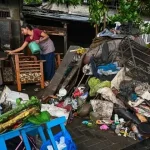KATHMANDU: An Indian climber has died while being helped down Mount Everest, just a couple of days after a Dutch and an Australian died near the peak. Two other Indian climbers are missing, and experts say some of the tragedy may have been avoidable.
Poor planning and overcrowding on the world’s tallest peak may have led to bottlenecks that kept people delayed at the highest reaches while waiting for the path to clear lower down, Ang Tshering of the Nepal Mountaineering Association said on Monday. “This was a man-made disaster that may have been minimised with better management of the teams,” he said. “The last two disasters on Everest were caused by nature, but not this one.”
Many had hoped this year’s climbing season would bring success and restore confidence in the route, after deadly disasters cancelled climbing the previous two years. But as hundreds of eager climbers, joined by local Sherpa guides and expedition experts, scrambled to take advantage of good weather to make it to the peak, reports of tragedy began trickling down the mountain.
First, a 35-year-old Dutch man, Eric Arnold, died on his way down from the peak from altitude sickness. Hours later, a 34-year-old Australian woman, Maria Strydom, died near the top, also after apparently suffering from altitude sickness.
On Monday, Subhash Paul of India was reported as the third death after succumbing to altitude sickness overnight as he was being helped down the mountain by Sherpa guides, said Wangchu Sherpa of the Trekking Camp Nepal agency in Kathmandu.
An Indian woman from Paul’s team, Sunita Hazra, was resting at a lower-altitude camp after becoming ill higher up. But two other Indian climbers — Paresh Nath and Goutam Ghosh — have been missing since Saturday. Wangchu Sherpa said it was unlikely they would be able to survive Everest’s hostile conditions.
Dozens of other climbers have developed frostbite or become sick near the summit in recent days, including the Australian woman’s husband, Robert Gropal, who was taken by helicopter to a hospital in Kathmandu on Monday for treatment.
Tshering said the competition between expedition organisers has become so fierce that they are dropping their prices, which can lead to compromises in hiring equipment, oxygen tanks and experienced guides to help get climbers to the top. “Teams are hiring raw guides that have no knowledge of responding to situations of emergency,” he said.
Since Everest was first conquered by New Zealander Edmund Hillary and Sherpa Tenzing Norgay in 1953, more than 4,000 climbers have reached the 29,035-foot-high peak.
Nearly 400 of those climbers reached the summit since May 11.
Nepal’s government had issued permits this year to 289 climbers, each of whom paid $11,000 to the government, plus another $25,000-$50,000 to an expedition company that provides guides, equipment and, often, bottled oxygen to use at high altitudes where the atmosphere is thin. The climbers are accompanied on the mountain by around 400 local Nepalese Sherpa guides.
Nepal and the Everest climbing community had been anxious for a successful season this year. The industry brings more than $3 million from permit fees alone into the poor, Himalayan country each year, and thousands of locals depend on the climbing season for secondary work as porters, hotel keepers or cooks.





